“I said ‘far out!’ when I discovered it, and it’s a very far out object,” said astronomer Scott Shepard from the Carnegie Institution for Science, as quoted by New Scientist.

The tiny planet is called 2018 VG18 — later nicknamed “Farout” by
the team that discovered it — and it’s about 3.5 as far away as Pluto,
some 18 billion kilometers (11.2 billion miles) away. That’s more than 100
times the distance between the Earth and the Sun — and about the same
distance as Voyager 2, the NASA probe that launched in 1977 and reached
interstellar space this month.
Farout was spotted by the Japanese Subaru telescope in Hawaii on November
10 by Shepard and several colleagues, according
to a statement on Carnegie Institution for Science’s website.
So far, Farout is still deeply mysterious. But one aspect already
attracting scientific interest is its unusual orbit. Farout orbits at an
unusual angle, along with other so-called “trans-Neptunian
objects.” There’s been a lot of speculation in recent years
about what might be causing those astronomical bodies’ unusual
trajectory.
One of the most popular explanations is the possible existence of a ninth planet,
or Planet X. In fact, the astronomers discovered Farout while searching for the
existence of a ninth planet, according to the statement. Most
recent data suggests it could also be a group
of objects within the same gravitational field.

An image of 2018 VG18 captured using the Subaru Telescope on 10 November.
Photograph: Scott S Sheppard/David Tholen
Slow and Pinkish
But we can glean at least some details about
Farout. Farout is estimated to be 500 km in diameter, and to take more
than 1,000 years to orbit the Sun. It also has a pinkish hue,
according to the researchers.
“With new wide-field digital cameras on some of the world’s largest telescopes, we are finally exploring our Solar System’s fringes, far beyond Pluto,” said Chad Trujillo, astronomer from Northern Arizona University.
The discovery shows that even though researchers are now routinely
finding planets orbiting other stars, there are still planet-sized undiscovered
objects in our own solar system. It really goes to show how much there still is
to learn about our relatively small corner of the galaxy.
Comments
Post a Comment